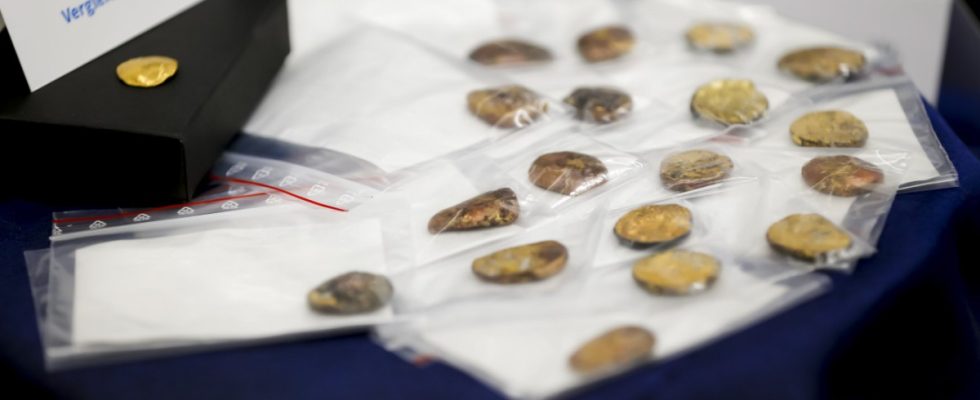Herbert Nerb still sounded confident on Thursday morning. It’s time “that our gold comes home,” said Manching’s mayor during a short phone call at the beginning of the shift. He even spoke of a “sensation”. The day before, it had become known that investigators arrested several men on Tuesday who are said to have stolen a Celtic gold treasure during a cinematic break-in at the Manching Celtic and Roman Museum. Even parts of the loot, which included 483 coins, were seized, it said. “I’m really happy about that,” Nerb said on the phone. But when he was met a few hours later at a press conference by the Bavarian State Criminal Police Office (LKA) in Munich, his joy had melted – like the Manching gold.
The local politician has just walked past a display case in the foyer of the LKA, which security personnel never take their eyes off of. In it, Nerb was able to examine the pride of his market town of Manching, or better: what is left of it. The investigators seized 18 bulky gold nuggets the size of salami slices during their search on Tuesday. “It hurts,” he says, taking a deep breath.
“Unfortunately, it has to be assumed that the Celtic treasure from Manching is no longer completely preserved in its original form,” said Bavaria’s Interior Minister Joachim Herrmann (CSU) at the press conference. A 43-year-old man from Berlin had the lumps of gold in a plastic bag with him when he – along with three other men – was arrested on Tuesday. A great success for the Bavarian police, says Herrmann.
Nerb sits just a few meters away from the minister and is silent – despite the success of the investigation, it is a sad day for him and his community. At least 70 of the 483 Celtic coins excavated from a field in Manching at the turn of the millennium have been melted down after initial analyses. Four coins per lump. 2000 year old history has been destroyed – probably in order to be able to sell the loot. Art Minister Markus Blume (CSU) speaks of an “attack on our cultural memory”. Investigators cannot say where the rest of the gold is and what condition it is in. The search continues.
At least the theory that the museum burglary last November was committed by a criminal Berlin clan will be dismissed on Thursday. The four arrested suspects are four Germans “without a migration background” between 42 and 50 years of age. “Career burglars,” says Interior Minister Herrmann. Three of them are said to have been around for years as a criminal gang and to have committed burglaries in several federal states and in Austria. According to Ingolstadt public prosecutor Nicolas Kaczynski, they have allegedly looted casinos, supermarkets and a vehicle registration office in eleven cases since 2014. The damage caused by booty amounted to more than half a million euros.
“Maybe they googled us and then the Celtic treasure came up at the top”
The Manchinger Museum was the gang’s first theft of culture, he says. The investigators have not yet been able to say how the perpetrators got hold of the Celtic gold. The suspects have not yet commented. Mayor Nerb suspects that they simply had “bad luck” and happened to be targeted by the criminals. “They spied on a lot of museums,” he says. “Maybe they googled us and then the Celtic treasure came up at the top.” According to the authorities, further burglaries were actually planned. In response to the spectacular coup, museums throughout Bavaria reviewed their security concepts, and Manching is also in the process of upgrading the outdated security technology. Too late.
The gang of criminals broke into the museum on a November night and within nine minutes pried open two doors and the floor display case with the treasure. The burglary was not noticed until the next morning, because the men had previously paralyzed a Telekom distribution box, which not only runs the Manchinger’s telephone and Internet connections, but also the museum’s alarm. There was no night security service, the security technology was outdated, and a surveillance camera provided unusable images. In addition, the group proceeded in a highly professional manner. But in the end, a DNA trace was enough to lure the police onto their trail.
During searches around the museum, investigators found two blue crowbars, pruning shears, side cutters and a radio antenna. The DNA secured on an object led to thefts in a nationwide database comparison, in which the perpetrators also first deactivated the alarm systems and used identical tools. The striking height of a more than 1.90 tall accomplice also helped the authorities. This week, more than 100 officers from Bavaria, Mecklenburg-Western Pomerania and Berlin finally searched 28 apartments, business premises, garden plots, a boathouse and vehicles.
Those arrested are charged with aggravated gang theft. They face prison sentences of between one and ten years, as prosecutor Kaczynski said. The accused are currently in custody. The group of four consists of a communications technician, an accountant, a retail store manager and an employee from a demolition company.
Herbert Nerb can be reached again on his cell phone an hour after the press conference. He first had to digest the information, he says, sounding more confident again. “I’m optimistic the rest of the treasure is still there.” Maybe the 18 gold nuggets were the first tranche and the remaining 400 coins were still in their original condition? “That would be the best case,” says Herb. And the worst case? “Of course it’s possible that all the coins have already been melted down and sold,” says the mayor.
All? Not quite. According to Nerb, the burglars forgot a single gold coin on the night of November 22nd. It must have fallen off during the raid, it was later found in a crack. “You could make replicas of this original,” says Nerb. It’s a small consolation.

